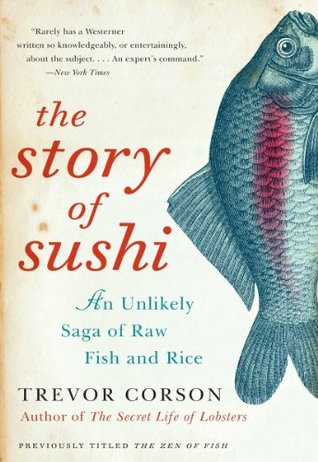More on this book
Kindle Notes & Highlights
bluefin is the worst to eat if you’re pregnant.
They have the most mercury.”
coal-burning power plants emit much of the mercury produced in the United States. Airborne mercury can travel from a factory smokestack halfway around
the world. Underwater volcanoes also pump mercury into the sea. Like PCBs, mercury spreads upward through the food chain and “bio-accumulates” in high-level predators. Bluefin tuna are the highest-level fish predator of all.
“Normally only the head chef cuts tuna,”
toward the tail, the meat contains more fiber and fetches a lower price.
“Tuna get a kind of ringworm,” Zoran said, pointing. “You don’t want to serve that. Right around the ringworm the meat gets watery.” Parasitic worms don’t make it into tuna as often as they do into smaller fish because tuna tend to swim in deep water, far from shore. But sushi chefs have to stay on guard. Zoran cut out the
worm and tossed it in the trash.
Salmon invest a lot in their roe, which is why salmon eggs are bigger than other caviar. A single salmon egg contains enough food to feed the embryo for an
entire winter and on into early spring, as the embryo becomes a baby fish.
A bit of salt plumps each egg and causes enzymes inside to digest proteins, generating more flavor-enhancing amino acids.
Salt also causes enzymes to strengthen the egg’s shell, making the eggs firmer and therefore more fun to eat.
Japanese food scientists have perfected techniques for manufacturing fake ones from vegetable oil.
Chefs who see customers using chopsticks or dipping the rice side in the soy sauce will pack the nigiri more tightly than is ideal. Even when a customer doesn’t dip the nigiri in soy sauce, many prefer to turn the nigiri
upside down so that the fish touches the tongue first, but that is a matter of preference. If the customer isn’t using soy sauce, it’s perfectly acceptable to put the nigiri in the mouth fish side up. Either way, a nigiri should always be eaten in one bite. It should also be eaten as soon as the chef serves it, so that it can be enjoyed at the proper temperature, with the rice still slightly warm.
Tradi...
This highlight has been truncated due to consecutive passage length restrictions.
sushi rolls—with the seaweed on the outside—should also be eaten right away, before the seaweed gets soggy. If the chef serves a platter, the rolls with seaweed on t...
This highlight has been truncated due to consecutive passage length restrictions.
The etiquette for eating sashimi—slices of raw fish without rice—is a bit different. Sashimi should al...
This highlight has been truncated due to consecutive passage length restrictions.
(It is bad form t...
This highlight has been truncated due to consecutive passage length restrictions.
chopsticks together before use. The assumption that the chopsticks contain splinters ...
This highlight has been truncated due to consecutive passage length restrictions.
To avoid losing the spiciness and flavor of the wasabi by mixing it with liquid, the customer should dab a bit of wasabi directly onto the slice of fish with his chopsticks,...
This highlight has been truncated due to consecutive passage length restrictions.
sauce. The garnishes that come with sashimi—usually a green perilla leaf and shredded radish—are meant to be eate...
This highlight has been truncated due to consecutive passage length restrictions.


